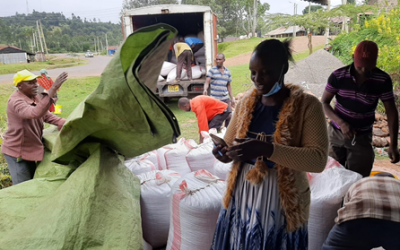
I was stranded and did not know where to get school fees for my children. Luckily, I had grown some Nyota beans on my one-acre land. When I harvested the beans, I took part of it to Abosi Cooperative. I’m happy the Cooperative came to my aid and bought the beans. I used the money I received to pay school fees. My child is now at Gorgor High School courtesy of beans. This is a testimony from Monica Chepngeno, a bean farmer in Gorgor Ndanai.
There is excitement in Gorgor, Ndanai Abosi Ward in the Bomet County of Kenya as men and women farmers deliver their beans to Abosi Top Hill Farmers’ Cooperative aggregation stores. It has been a successful season of learning about bean production and business. The farmers trickle into the Cooperative compound balancing baskets of beans on their heads, some in sacks on bicycles, motorbikes, animal-drawn carts, and pick-up trucks delivering their grains to the Cooperative aggregation. The season has been bumper!
Helen Keti Ruto, the Chairperson of Abosi Top Hill Farmers’ Cooperative, beams with satisfaction as she recalls how the journey started.
‘This is our first time to produce this much beans. Previously, we produced small volumes of beans often sold locally. This time, our two stores are full of over 100 bags of beans and we can afford to call in an offtaker with a 10-ton lorry to buy the beans!’ she explains as she guides the group members on how to grade, pack and load the sacks on the truck.
Abosi Top Hill Farmers’ Cooperative Society Limited started as Abosi Vision 2030 in 2017 with the aim of supporting its members in agricultural production. At the time, Abosi Vision 2030 worked through Kaplomboi ROTU Cooperative Society. The transition to Abosi Top Hill Cooperative Society happened in 2020 when the group registered as a Cooperative with support from the Cereal Growers Association (CGA). The group had 85 members upon registration. The membership has grown to 150 of which 98 are women and the youth constitute 30 female and 17 male.
This story is originally published on PABRA Africa Blogs.
